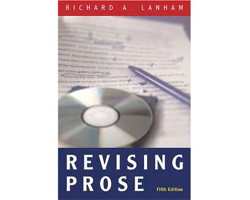 I want to become a better writer. So when I saw Jason Fried, CEO of 37signals, tweeting last month that Richard A. Lanham’s book Revising Prose was “the best book on writing & editing I’ve ever read”, I had to get myself a copy. I was not disappointed.
I want to become a better writer. So when I saw Jason Fried, CEO of 37signals, tweeting last month that Richard A. Lanham’s book Revising Prose was “the best book on writing & editing I’ve ever read”, I had to get myself a copy. I was not disappointed.
In Revising Prose, Lanham attacks what he terms The Official Style – the lazy, bureaucratic style of writing where nouns dominate and the only verbs to be found are forms of the verb “to be” followed by a litany of prepositional phrases. He introduces a technique he calls the Paramedic Method as a way to put Official Style sentences into action. It consists of eight steps:
- Circle the prepositions.
- Circle the “is” forms.
- Find the action.
- Put this action in a simple (not compound) active verb.
- Start fast – no slow windups.
- Read the passage aloud with emphasis and feeling.
- Write out each sentence on a blank screen or sheet of paper and mark off its basic rhythmic units with a “/.”
- Mark off sentence length with a “/.”
He measures his success in reducing unnecessary words using a metric he calls a Lard Factor, which is the number of words removed divided by the original sentence length. For example, in the first chapter, he applies the first five steps of the Paramedic Method to the sentence:
In response to the issue of equality for educational and occupational mobility, it is my belief that a system of inequality exists in the school system.
Highlighting the prepositions and “is” forms results in:
In response
to the issue
of equality
for educational and occupational mobility,it is my belief that a system
of inequality exists
in the school system.
Lanham identifies that the action, buried under all the prepositions and “is” forms, is “believe”, so he revises the sentence as follows:
I believe that gender inequality exists in the schools.
This took the sentence from 26 words down to 9 words, a Lard Factor of 65%.
Revising my own writing
I decided to apply Lanham’s techniques to my own writing. First, I found a sentence from my db2top Gauges blog post that is littered with prepositional phrases:
The size of the sequence of ‘u’ characters is the amount of user CPU time measured in the last interval divided by the average amount of user CPU time + system CPU time measured since the last snapshot reset or database activation.
Highlighting the prepositions and “is” forms results in:
The size
of the sequence
of ‘u’ characters
is the amount
of user CPU time measured
in the last interval divided
by the average amount
of user CPU time + system CPU time measured
since the last snapshot reset or database activation.
Here is my attempt to rewrite it:
When you reset the snapshot monitor or activate your database, db2top starts computing a CPU time average. It divides recent user CPU time by this average and repeats the letter ‘u’ proportionally.
That takes me down from 42 to 32 words. I admit it could use some work.
The book itself
The book is an easy read at just 145 pages plus 18 pages of exercises at the end. The many, often hilarious examples of bad writing keep things light and fun.
In many ways, Revising Prose reminds me of Martin Fowler’s book Refactoring, had it been a book about writing instead of computer programming. The techniques for systematically identifying bad writing bring to mind the concept of code smells and I cannot help but see the similarities to refactoring in the method of revising whole documents by making small, reversible changes to individual sentences. Perhaps someday writers will have their own automated refactoring tools.
Reviewed by Keith McDonald on June 14, 2010.
Eight simple steps to better writing
Lanham’s Paramedic Method helps you breathe life back into your writing by replacing the noun-dominating Official Style with strong action words, cutting out needless prepositional phrases, and injecting voiceless prose with rhythm.
Rating:

Pingback: ZWConcepts » Blog Archive » 8 Simple Steps To Improve Your Writing()